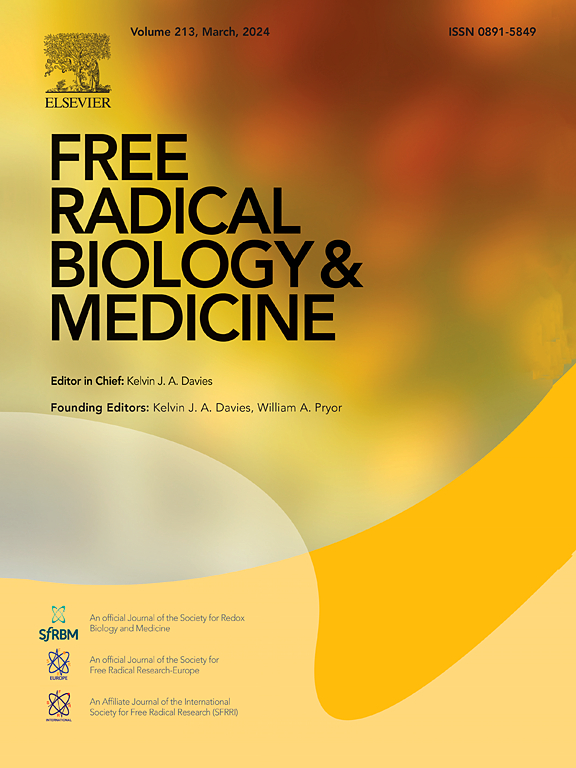Baicalin restores dopamine homeostasis in the ADHD model by regulating DAT-VMAT2 transport imbalance through activation of the Nrf2/Keap-1/HO-1 pathway
IF 7.1
2区 生物学
Q1 BIOCHEMISTRY & MOLECULAR BIOLOGY
引用次数: 0
Abstract
The 'dopamine (DA) deficit' theory is pivotal in understanding the pathogenesis of attention deficit hyperactivity disorder (ADHD). However, the relationship betweeen an imbalance in the dopamine transporter (DAT) and vesicular monoamine transporter 2 (VMAT2) the DA deficit remains poorly understood. Using the internationally recognized spontaneously hypertensive rats (SHRs) models, we investigated how a high oxidative stress (OS) state in vivo disrupts DAT-VMAT2 transport balance, a key factor influencing DA homeostasis. Our findings revealed abnormal levels of 8-hydroxy-2′-deoxyguanosine (8-OHdG), catalase (CAT), total antioxidant capacity (T-AOC), glutathione (GSH), and tumor necrosis factor-α (TNF-α) in SHRs. Furthermore, the antioxidative stress-related nuclear factor erythroid 2-related factor (Nrf2)/kelch-like ECH-associated protein 1 (Keap-1)/heme oxygenase-1 (HO-1) pathway was inhibited, leading to excessive DAT activation and functional antagonism of VMAT2. Notably, Baicalin (BA) ameliorated these imbalances. Treatment with the VMAT2 inhibitor tetrabenazine (TBZ) exacerbated VMAT2 inhibition in SHRs brains, further activating DAT and restricting Nrf2 nuclear translocation. These results confirmed the strong link between the Nrf2/Keap-1/HO-1 pathway the DAT-VMAT2 imbalance. Moreover, under high OS conditions, the phosphorylation of nuclear factor-κB P65 (NF-κB P65) was triggered, leading to the upregulation of heat shock cognate protein 70 (HSC70). We aslo identified a potential negative feedback mechanism between HSC70 and VMAT2. In summary, our study uncovered a novel mechanism in ADHD pathogenesis, demonstrating that the DA deficits resulted from an imbalance between DAT and VMAT2. Remarkably, BA significantly reduced high levels of OS and inflammation by activating the Nrf2/Keap-1/HO-1 pathway, thereby restoring DAT-VMAT2 transport balance and enhancing DA homeostasis. This discovery provides a solid foundation for further exploration of ADHD pathogenesis and offers new molecular insights for ADHD treatment.

黄芩苷通过激活Nrf2/Keap-1/HO-1信号通路调节DAT和VMAT2转运之间的平衡,从而影响多动症模型中的多巴胺稳态。
本文章由计算机程序翻译,如有差异,请以英文原文为准。
求助全文
约1分钟内获得全文
求助全文
来源期刊

Free Radical Biology and Medicine
医学-内分泌学与代谢
CiteScore
14.00
自引率
4.10%
发文量
850
审稿时长
22 days
期刊介绍:
Free Radical Biology and Medicine is a leading journal in the field of redox biology, which is the study of the role of reactive oxygen species (ROS) and other oxidizing agents in biological systems. The journal serves as a premier forum for publishing innovative and groundbreaking research that explores the redox biology of health and disease, covering a wide range of topics and disciplines. Free Radical Biology and Medicine also commissions Special Issues that highlight recent advances in both basic and clinical research, with a particular emphasis on the mechanisms underlying altered metabolism and redox signaling. These Special Issues aim to provide a focused platform for the latest research in the field, fostering collaboration and knowledge exchange among researchers and clinicians.
 求助内容:
求助内容: 应助结果提醒方式:
应助结果提醒方式:


